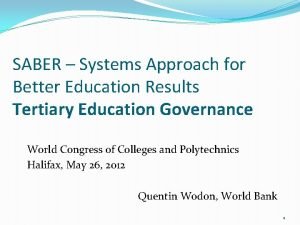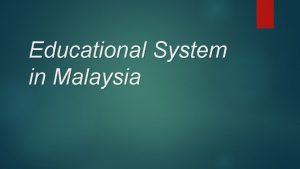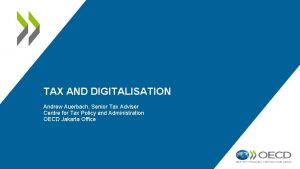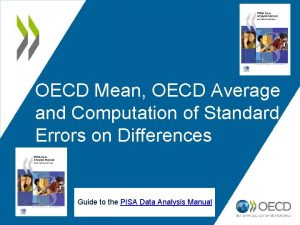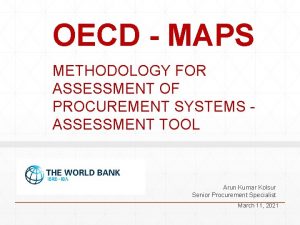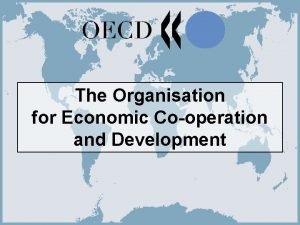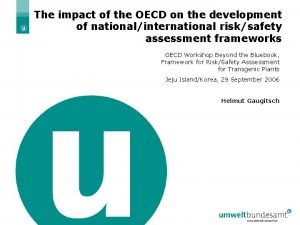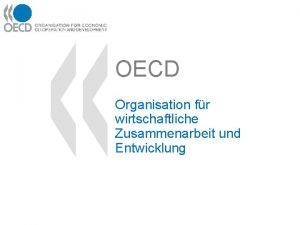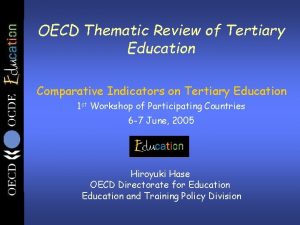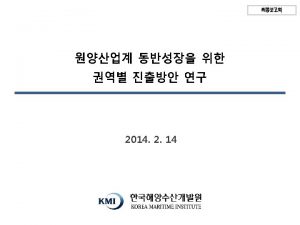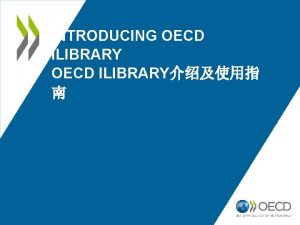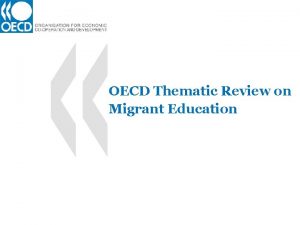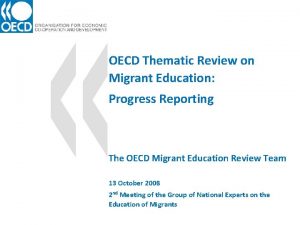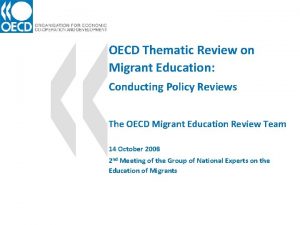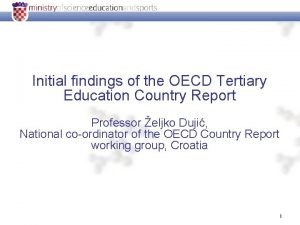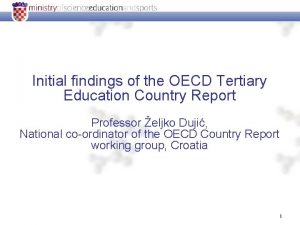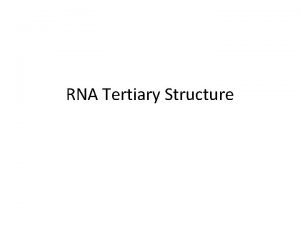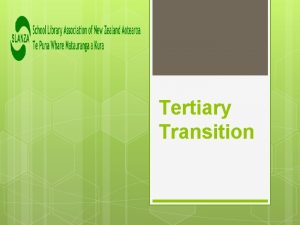The OECD Thematic Review of Tertiary Education Synthesis






































































- Slides: 70

The OECD Thematic Review of Tertiary Education Synthesis Report What have we learned? Presentation by Paulo Santiago, Karine Tremblay and Ester Basri, OECD Tertiary Education for the Knowledge Society International Conference, Lisbon, 3 -4 April 2008

Outline of Presentation Part 1: Key features of the OECD Thematic Review of Tertiary Education Part 2: Focus on policy recommendations across a range of areas with some description of the analysis undertaken in the report • • • Governance Funding Equity Links to the labour market Academic career Role in research and innovation Quality assurance Internationalisation Policy development and implementation

Part 1: Key features of the OECD Thematic Review of Tertiary Education

The OECD project’s contribution Objective Recommend policies that ensure that capabilities of tertiary education contribute to countries’ economic and social goals A collaborative, cross-national process to: • Synthesise research-based evidence on the impact of tertiary education policies and disseminate this knowledge among participating countries • Identify innovative and successful policy initiatives and practices • Facilitate exchanges of lessons and experiences among countries • Identify policy options and the conditions under which they are successfully implemented

Key features of Review • A broad range of areas covered – – – – – Governance Funding Quality assurance Equity Role in research and innovation Academic career Links with the labour market Internationalisation Policy development and implementation • 24 participating countries – 14 of which hosted a country review visit

Key features of Review • A wide range of stakeholders involved - National Co-ordinators and Steering Committees in participating countries - 52 external reviewers from 22 countries involved in visits - About 140 institutions visited and about 4000 persons interviewed - Other OECD units (STI, ECO, EDU - IMHE, CERI, IAD) - Links established with other international organisations and key stakeholder groups (business community, unions, students) • And … a range of outputs - 24 Country Background Reports (CBRs) - 14 Country Notes (Publication series) - Expert/Background papers commissioned - Qualitative data collected - Final Synthesis Report - 4 Workshops of participating countries - 4 Visits to “analytical review” countries to discuss CBRs - Dissemination Conferences in countries (6 already organised, a number planned) - International Conference in Lisbon on 3 -4 April 2008 Final Synthesis Report Brings together the evidence collected and materials produced through the OECD Review and presents the key findings and policy messages

Steering tertiary education: setting the right course

Aspects under analysis Section 1: Governance of tertiary education: concepts and dimensions - Nature of governance systems Regulation Dimensions of institutional autonomy Market-type mechanisms in tertiary education Section 2: Steering tertiary education institutions: patterns, trends and drivers of change Section 3: Structuring the tertiary education system Section 4: System Linkages - Linking secondary to tertiary education Linking tertiary education to working life Linkages within tertiary education system Linkages with surrounding regions and communities. Section 5: Institutional governance

Policy priorities Strategy Develop a coherent strategic vision for tertiary education: – Devise a statement of strategic aims for tertiary education Coherent vision in harmony with national social and economic objectives – Draw on a comprehensive advisory body to establish strategic aims for tertiary education National Council or Forum of Tertiary Education to assist with the integration of strategic leadership, policy planning and co-ordination among the main actors

Policy priorities Steering Establish sound instruments for steering tertiary education: – Ensure that the capabilities of Ministries keep pace with changing responsibilities From administration to policy steering and performance evaluation – Develop steering instruments to establish a balance between institutional autonomy and public accountability Instruments for steering that achieve accountability and link institutional performance to national purposes while also permitting a wide scope for institutional autonomy – Use student choice as a means by which to improve quality and efficiency

Policy priorities Structure, diversification and coherence Ensure the coherence of the tertiary education system within extensive diversification: – Grasp the benefits of wider and more flexible diversification among tertiary institutions – In systems with vocationally-oriented sectors, ensure that mechanisms exist to discourage academic drift – Avoid the fragmentation of the tertiary education system

Policy priorities System linkages Build system linkages: – Ensure appropriate co-ordination between secondary and tertiary education systems – Review whether the tertiary education system is contributing effectively lifelong learning – Build linkages between different types of tertiary education institutions Flexible learning paths and validation of previous learning experiences – Foster the engagement of institutions with surrounding regions and communities Part of mission statement; engagement of regional stakeholders

Policy priorities Alignment of institutions to national strategy Strengthen the ability of institutions to align with the national tertiary education strategy: – Ensure the outward focus of institutions – Require institutions to establish strategic plans Basis for general accountability; to be published; intrinsic value – Examine how best to widen the scope of institutional autonomy – Create a national policy framework that gives institutions the means to effectively manage their wider responsibilities External representation in institutions’ governing bodies

Matching funding strategies with national priorities

Aspects under analysis Section 1: Trends in funding tertiary education Section 2: Why do governments intervene in and subsidise tertiary education? - Efficiency concerns (externalities, imperfection of human capital markets, incomplete information) - Equity concerns Section 3: Why should students (or graduates) contribute to the costs of tertiary education? - Forms of and trends in cost-sharing in countries - The case for cost-sharing There is a need for other-than-governmental revenue Those who benefit should contribute to the costs Public savings from ind. contributions can be channelled to improve equity Tuition fees might improve efficiency - Practical issues with and arguments against cost-sharing - Impact of cost-sharing

Aspects under analysis Section 4: Overall country approaches to funding tertiary education Section 5: Tuition fees Section 6: Allocation of public subsidies to institutions Section 7: External sources of institutional funding Section 8: Funding institutional infrastructure Section 9: Impact of funding approaches on the supply of tertiary education Section 10: Funding for students Section 11: Efficiency of funds use by institutions

Policy priorities Strategic Approach Develop a funding strategy that facilitates the contribution of the tertiary education system to society and the economy: – Making funding approach consistent with the goals of the tertiary education system Goals might include expansion, excellence, relevance, equity, social mobility, institutional capacity. – Ensure that the funding approach embraces a number of desirable features: • • • Transparent, flexible, predictable, fair; Ensures public accountability; Permits freedom to innovate; Sensitive to institutional autonomy; demand-driven; Recognises the missions and profiles of individual institutions; In some circumstances, is open to private institutions. – Articulate a long-term strategy

Policy priorities The principle of cost-sharing Use cost-sharing between the State and students as the principle to shape the funding of tertiary education: – Provide public subsidies for tertiary education subsidies, regardless of sector of provision – Charge tuition fees to students, especially if limited public funding either: • rations the number of students; • jeopardizes levels of spending per student; or • restricts financial support for disadvantaged groups. – Countries with little tradition of fees should launch a public debate on the consequences of an heavy reliance on public money for funding tertiary education – Consider tuition fee stabilisation policies to ensure cost containment and moderation – Allow institutions to differentiate tuition fees across courses

Policy priorities Basis to allocate public subsidies Publicly subsidise tertiary programmes in relation to the benefits they bring to society Implications: q the public funding of educational activities which generate educational externalities (benefits to others not appropriated by the individual receiving the education) to the benefit of society as a whole, irrespective of the nature of the provider q levels of public funding which reflect the magnitude of educational externalities relative to private benefits Difficulty: assess educational externalities Possibilities: q differentiate by type of programme (shortage areas, if it responds to labour market needs, foster innovation or serve communities’ aspirations) q approval of new programmes to be preceded by an assessment of relevance q interconnectedness with quality assurance

Policy priorities Institutional Funding Institutional funding for instruction should be formula-driven, relate to both input and output indicators and include strategically targeted components: – Block grants should rely on transparent formulas based on a balanced array of input and output indicators – Performance-based funding mechanisms should be carefully implemented – A possible model is a contractual relationship between institutions and the State – Institutional funding to include targeted development programmes – Institutional funding to be adjusted to the particular mission of the institution – Institutions to be autonomous in the use of their block grants – Funding to offer some stability for long-term development – Sources of institutional funding to be diversified – Complementary streams for the funding of capital infrastructure

Policy priorities Institutional cost effectiveness Improving cost-effectiveness – possible responses: – More funding on the basis of graduation rates – Reduction of public subsidies for students who remain too long in the system – Conversion of loans into grants if students graduate within nominal time – The elimination of low enrolment and/or duplicated programmes with possible redeployment of academics across education programmes – Rationalizing faculty to respond to student contractions – Increasing use of shared facilities – Increasing student mobility between institutions

Policy priorities Student Support Back the overall funding approach with a comprehensive student support system: – Aim for a universal student support system with two major components: • A loan system with income-contingent repayments; • A means-tested grants scheme. – Grants scheme to be based on assessed need – Loans system to be universal with income-contingent repayments and means-tested subsidies – Student aid entitlements to cover living costs – Students who attend private institutions should benefit, under the same conditions, from the student support system – Creation of an agency to manage the student support system

Achieving Equity

Aspects under analysis Section 1: Defining equity in tertiary education Section 2: Contextual developments affecting equity in tertiary education - Inequities in tertiary education are, to a great extent, dictated by inequities in preceding levels of education - Expansion and diversification of tertiary education have had implications for equity Section 3: Trends in equity in tertiary education - Little information to assess the extent of inequities in tertiary education - More disadvantaged students are overrepresented among those students who are not eligible to access tertiary education When gaining access to tertiary education, more disadvantaged students enrol in greater proportions in lower status institutions and more vocationally-oriented institutions - There is strong evidence that access to and participation in tertiary education is associated with the socio-economic background of students

Aspects under analysis Section 4: Factors affecting equity in tertiary education and country policy responses - Funding-related factors - Family background - School factors - Peer effects - Articulation between secondary and tertiary education - Organisation of tertiary education - Selection procedures

Policy priorities Assess extent and origin of equity issues: Systematic collection of data. Making tertiary education more equitable requires policy to intervene much earlier Career guidance and counselling services at the school level are instrumental in improving equity of access Provide opportunities for tertiary education study from any track in upper secondary school Strengthen the integration of planning, policy and analysis between secondary and tertiary education systems Diversify the supply of tertiary education to accommodate a more diverse set of learners

Policy priorities Consider alternative types of provision to account for the cultural diversity of the population Development of institutions with diverse cultural foundations Improve the access to tertiary education in remote areas by expanding distance learning and regional learning centres Diversify criteria for admission and give a say to institutions in entrance procedures Consider positive discrimination policies for particular groups whose prior educational disadvantage is well identified Consider alternative ways of acquiring eligibility for tertiary education

Policy priorities Improve transfers between different types of institutions within tertiary education Provide incentives for tertiary education institutions to widen participation and provide extra support for students from disadvantaged backgrounds Special financial incentive for institutions to attract less represented groups; positive discrimination; studies progression support (e. g. tutoring services); adapting the learning environment to account for the diversity of the student body. Encourage institutions to be more responsive to the needs of adult learners

Policy priorities Sustain efforts to improve gender parity at all levels of tertiary education and address gender stereotyping in subject choice Grant special provisions for students with disabilities - Targeted support: accessibility to the buildings; resources for institutions to provide special support; special entrance procedures; targeted grant schemes. - Account for special rhythms. - Avoid stigmatisation. - Life course perspective. - Distance learning opportunities. Place more emphasis on equity of outcomes

Strengthening ties with the labour market

Aspects under analysis Section 1: Labour market outcomes of tertiary graduates Section 2: The skills and abilities of graduates Section 3: Aligning tertiary education supply with labour market demand Student demand Steering by public authorities The role of other actors in tertiary education National qualifications frameworks and quality assurance systems

Policy priorities Co-ordinate Labour Market and Education Policy: Better integration between these two policy domains – integration of education, training, and employment, through the institution of cabinet-level committee for human capital; Ä More attention to be devoted to labour market concerns (e. g. provision of lifelong learning opportunities; flexible study options). Ä Improve data and analysis about graduate labour market outcomes Lack of data on LM outcomes impairs student adaptation to labour market signals; the capacity of authorities to adapt resource allocation to labour market needs; and the ability of institutions to respond to LM needs. Ä Better data and analysis equally necessary in systems that rely upon central allocation of study places. Ä Increase the capacity of institutions to respond to demand: Funding methodologies must create incentives for institutions to respond to enrolment demand, including the reallocation of resources within the institution. Ä

Policy priorities Enhance provision with a labour market orientation Engagement with employers and professional organisations. Ä Creation of vocationally-oriented institutions. Ä Provision of short-cycle programmes. Ä Avoid ‘academic drift’. Ä Strengthen partnerships between institutions and the business sector: internships for students, dedicated liaison offices in institutions. Ä Strengthen career services at secondary and tertiary educational levels Involve labour market perspectives and actors in policy development and institutional governance - In the formulation of national tertiary education policies through advisory bodies; - Widen their participation in the bodies responsible for the strategic governance of tertiary education institutions. Encourage TEIs to play a greater role in lifelong learning Explore the potential of a National Qualifications Framework

Academic career: adapting to change

Aspects under analysis Section 1: Developments within the academic workforce - Academic workforces are ageing in a number of countries - Gender inequalities remain within the academic profession - Some countries reveal difficulties in the recruitment of high-quality academics - Countries have different traditions of within-country academic mobility - Cross border academic mobility is increasing Section 2: The changing roles of academics - The nature of academic work has been affected by a number of trends in tertiary education Expansion (greater diversity of student body/programmes) Growing share of private funding Focus on accountability and performance - There are new expectations and demands on academics Increased workload Challenges for research activities A new relationship with institutional governance Traditional academic values challenged

Aspects under analysis Section 3: Features of the academic profession - Responsibility for the management of the academic career and employment status of academics Centralised versus decentralised approaches - Employment conditions and career structure Contractual arrangements The debate on academic tenure Career structure Appointment and promotion Multiple employment - Compensation and rewards Salary setting Salary differentiation - Range of tasks performed by academics (including research vs teaching) - Career management Formative assessment Responses to underperformance Professional development

Policy priorities Give institutions ample autonomy over the management of human resources, to include: - Faculty and staff to be formal employees of tertiary education institutions Institutions with broad discretion over the setting of academic salaries Institutions with the freedom to create academic positions in agreement with the strategy defined by their governing authority Institutions to determine the range of career structures which better reflect the distinct roles academics play within them Institutions to be given the responsibility to design promotion systems, assessment systems and professional development strategies Manage the academic career in a flexible manner - Flexibility on the roles and workloads of academics within institutions Career structures should reflect the diversity of roles and missions of institutions Within broad direction provided by institutional leadership, academics to assume responsibility for shaping their role and profile Flexibility with types of employment contracts Debate the merit of long career ladders

Policy priorities Reconcile academic freedom with institutions’ contributions to society – in practice, could translate into academics: - pursuing their objectives while accounting for institutional goals - being provided with support and conditions to meet what the institution and society expect from them - being autonomous in the design of the courses they teach - benefiting from freedom to select research topics and approaches to research, possibly within priorities defined collectively either at the institution or system level - not being constrained in their interpretation of research results and of the knowledge conveyed to students - not being prevented from publicising the results of their research or the outputs of their service to the community - being held accountable for the outcomes of their academic activities Enhance the attractiveness of the academic career - Target larger salary rises to particular groups - Provide a dynamic knowledge-rich work environment, opportunities for career growth, prospects for a stable career, formal mechanisms to recognise the work of academics and opportunities for mobility and collaboration with external organisations.

Policy priorities Improve the entrance conditions of young academics - Well structured induction schemes, effective recruitment processes, prospects for a stable and rewarding merit-based academic career - Supporting environment upon entry into the academic career: e. g. reduced teaching load, availability of mentoring by senior academics, special funds to create research groups, and availability of training programmes to help young academics familiarise with a number of key processes - Probationary process Strengthen management processes and leadership - To provide the framework for linking individual academic work to institutional strategic goals - Needs to demonstrate the advantage of change, establish a systematic forwardlooking assessment of organisational direction, and define the requirements and workloads needed to achieve the desired profile.

Policy priorities Evaluate and reward the accomplishments of academics - Put in place mechanisms which grant feedback to academics and reward their accomplishments - Performance management to define expectations for staff and provide feedback and development opportunities - More emphasis on rewarding accomplishments of academics in areas other than research - Consolidate mechanisms to reward academics for exemplary performance Integrate professional development throughout the career - Lifelong learning approach to the academic career - Professional development: entitlement-based; incentive-based; institution-based - Centres for teaching and learning - Opportunities for experiences outside academic organisations

Policy priorities Develop mechanisms to support the work of academics - Support the work of academics and recognise the wide variety of tasks that academic work actually entails - Protect academics from excessive demands: e. g. administrative units; teaching and learning centres; offices to advise students Enhance the capacity for collaboration and encourage mobility - Mutual recognition of academic career structures across institutions; portability of entitlements to leave and retirement benefits Recognition of skills and experience acquired outside academia; provision of flexible re-entry pathways to the academic profession Forms of collaboration such as Centres of Excellence Steps to limit ‘in-breeding' Provide more flexible employment conditions for senior academics - Attractive working environments for older academics: e. g. prof. dev. activities tailored to meet their needs; more flexible working arrangements; new roles.

Enhancing the role of tertiary education in research and innovation

Aspects under analysis Section 1: The role of TEIs in research & innovation – – Building knowledge bases and capabilities Developing human capital Knowledge diffusion and use Knowledge maintenance Section 2: The tertiary education research & innovation environment – – – R&D trends Scientific and technological output (publications and patents) Human resources for science and technology (HRST) Linkages & knowledge transfer Intellectual property rights and commercialisation

Aspects under analysis Section 3: The governance of TEI research • Development of overarching national strategies – Involves inter-ministerial councils, institutions etc. • Priority setting – Selecting and defining complex. Difficult to link priorities with the S&T system • Funding research – Balance between allocation mechanisms changing • Evaluating research – Important to ensure efficiency, but difficult to assess impacts • Creating critical mass – Identifying critical mass across different fields unclear

Policy priorities (1) Knowledge diffusion: • Improve knowledge diffusion rather than focusing on commercialisation – Role of TEIs is to create and diffuse knowledge but commercialisation requires secrecy – Results of success are skewed – Innovation requires access to knowledge • Widen channels of interaction – Improve linkages, particularly with SMEs • Foster mobility – Inter-sectoral mobility between TEIs, firms and public research institutions – International mobility (but this is not a substitute for domestic supply)

Policy priorities (2) Developing human resources: • Improve research career prospects – Career opportunities limited: job insecurity, salaries, work dissatisfaction etc • Improve data on human resources – Demand for the highly skilled increasing – Mismatches unknown • Innovation requires a variety of skills – Vocational training – Non-technological innovation – Traditional research careers changing

Policy priorities (3) Building capabilities: • Maintain adequate research infrastructure – Basic resources – Large scientific facilities may require collaboration • Use TEIs to foster the internationalisation of R&D – Success in the global economy largely depends on national capabilities – Measures to improve research capabilities will increase attractiveness for R&D investment

Policy priorities (4) Enhancing the system (1): • Improve methods for priority selection – Lack of systematic approach – Tends to focus on high-technology rather than national technological specialisation – Need to consider emerging areas, social sciences and humanities • Broaden assessment criteria and monitor impacts – Some performance measures have had unintended impacts on research quality – Shift towards more project-based funding may also have unintended impacts – Broad range of performance indicators required

Policy priorities (5) Enhancing the system (2): • Ensure policy considers long-term perspective – Knowledge production often involves long time-lags between discovery and application. • Evaluate and co-ordinate policies across the whole system – TEIs integral part of the research and innovation system – Policies need to be coherent and evaluated as part of the wider system

Assuring and improving quality

Aspects under analysis Section 1: Introduction - - What is quality assurance (QA) and why does it matter? Can be broadly defined as the “systematic, structured and continuous attention to quality in terms of quality maintenance and improvement” Both Accountability and Improvement dimensions Interest in QA driven by several factors Massification + rise NPM approach in public service provision insight into cost-effectiveness & accountability Development private provision + internationalisation consumer protection Advent of New Economy demands for quality tertiary education New models of governance (distant steering: autonomy with accountability) Different forms of QA Accreditation Pass/Fail Assessment Grade Audit Qualitative But a common puzzle: the ambivalence of purposes Section 2: Current practices in QA systems - Diversity in approaches In terms of level of evaluation (TEI vs programme), scope (territorial, type of TEI), initiation, frequency, actors involved, instruments used, outcomes, followup and consequences

Aspects under analysis Section 3: Issues at stake and policy challenges - - - Designing an effective QA framework Is it possible to combine accountability and improvement? How many QA agencies and what scope for their activities? Implications of internationalisation: cooperation and comparability Should performance indicators be used and how? Building consensus and trust with various stakeholders Ensuring successful implementation: different conceptions of QA, resistances and implementation gap Building internal ownership and trust Enhancing the cost-effectiveness of the QA system Costs of evaluations, links with research evaluations Addressing the implications of internationalisation for QA Transparency towards international actors International standards and guidelines (ESG), European Register (EQAR) Maximising impact of the QA system Difficult measurement (teaching, learning, institutional management) Avoiding undesired outcomes (intellectual diversity, acccreditation mills, insufficient preparedness of users) Incentives

Policy priorities Design of the QA framework Build consensus on clear goals and expectations of the QA system – Expectations from QA aligned to overall tertiary education strategy – Reconcile different perceptions of quality to build national commitment to QA – Distinguish accountability and improvement to build consensus Ensure that QA serves both improvement and accountability purposes – Find the right balance between them – Revisit this balance periodically move to audit once baseline standards are met Combine internal and external quality assurance mechanisms – Most effective to address the different purposes of QA – Specific mechanisms according to traditions and level of QA development Build capacity and secure legitimacy – QA agency: independant from Ministry, trust of TEIs – Involve academic community in external teams

Policy priorities Design of the QA framework (ctd) Make stakeholders visible in the evaluation procedures – Students and employers in external teams, graduate surveys – To build legitimacy Increase focus on student outcomes – Shift focus from inputs to learning and labour market outcomes – Develop and publish indicators of teaching quality, cognitive outcomes – National qualification frameworks, LM indicators, graduate perspectives in QA Enhance the international comparability of the QA framework – Convergence & mutual recognition of national QA systems, international guidelines – Involve international experts, publish results in English

Policy priorities Strengthen internal evaluation Develop a strong quality culture in the system – Make internal QA systems mandatory, incentives (e. g. publish qualityrelated info) – Builds-up over time Put more stress on internal QA mechanisms – Less costly and more effective than periodic and comprehensive external reviews – Role of QA agency: technical assistance, promote dialogue and bestpractice Ensure that internal accountability is guided by some key principles – Avoid burdensome processes – Delegate responsibility for QA to those able to effect changes – Support peer observation but separate it from probation/promotion processes Undertake the external validation of internal QA systems – E. g. involve external examiners

Policy priorities Improve external evaluation Commit the external QA to an advisory role as the system gains maturity… – Role of QA agency: to evolve towards research, benchmarking indicators, research, best-practice … but retain strong external components in certain contexts – E. g. early stages of development, large expansion, large private sector Implement adequate follow-up procedures and view QA as a continuous process – Necessary condition to have an impact. Consequences must be clear – Concentrate improvement efforts on institutions most in need Allow for selected assessments to be initiated by an external QA agency – Flexibility for ad-hoc evaluations, e. g. in case of problem, specific topic Avoid direct links between results and public funding decisions – Prefer ex-ante links with funding (e. g. to be eligible for funding) to expost links – Limit financial rewards to better assist low-performing institutions

Policy priorities Methods Align QA processes to the particular profile of institutions – E. g. more focus on LM relevance in tertiary vocational institutions Improve co-ordination between the evaluation of teaching and research – To avoid duplication burden Innovation Develop QA expertise in new areas – E. g. LLL, off-campus provision, use of value-added indicators in quality evaluations

Policy priorities Practical arrangements for the QA system Avoid fragmentation of the QA organisational structure – Better integration and coherence, spread best practice within system – More accountability with system-wide standards and more transparency Avoid excessive costs and burdens – Transaction costs: duplication QA activities, fragmented system with many TEIs Improve quality information base Improve information dissemination – E. g. Quality-related information on the web – As an incentive for improvement through student choices

Shaping internationalisation strategies in the national context

Aspects under analysis Section 1: Introduction - - “Process of integrating an international, intercultural or global dimension into the purpose, functions or delivery of tertiary education” Globalisation as the catalyst, internationalisation as the (proactive) answer Many drivers Globalisation of skilled LM demand for international skills National skill development strategy Foster exchange and co-operation Bottlenecks in provision or inter-system complementarities Trade value, economic implications TEIs compensate for projected decline in enrolments, generate revenues Different forms of internationalisation Convergence of tertiary education systems and recognition arrangements Internationalisation ‘at home’ Student and academic mobility Institution and programme mobility usually different forms of transnational education in parallel

Aspects under analysis Section 2: Trends in internationalisation of TE - - - Students and academics’ mobility Dramatic growth in student mobility over past 3 decades Emergence of new players in recent years No clear evidence of similar trends for academics, except short term Other emerging forms of internationalisation Internationalisation of curricula gained momentum over past decade Bologna Process “We are at the beginning of the era of transnational higher education” A range of policy levers Language of instruction, reputation, legislation on transnational education, immigration policy, marketing, course databases, poles of excellence, grants schemes, portability of public funding, tuition fee policy, mobility programmes Section 3: Issues at stake and policy challenges - Policy coherence Protecting students and safeguarding reputation Transparency, comparability and portability of qualifications Equity Sustainability of internationalisation strategies Migration implications: brain drain, gain or circulation?

Policy priorities Overall strategy and steering of internationalisation policy Develop a national strategy and comprehensive policy framework for internationalisation – Build on country-specific advantages/constraints resist replication Improve national policy coordination – Inter-governmental committee to maximise synergies among policies Immigration, S&T, Labour, Foreign Affairs Encourage institutions to become proactive actors of internationalisation – Framework conditions to make TEIs more responsive to internat. envt int° chapter in annual negociations, remove blockages, incentives Promote sustainable strategies of internationalisation – Diversify activities, partners, distribution of internat. students within system Create structures to assist TEIs in their internationalisation strategies Provide adequate funding to implement internationalisation strategies

Policy priorities Strengthen attractiveness and competitiveness of TE system Create structures to promote the national tertiary education system – E. g. ‘marketing’ agency, capitalise on diplomatic missions abroad Enhance the international comparability of tertiary education – E. g. Bologna-compatible degree structures, credit transfer schemes Develop alternatives to current global rankings – E. g. instruments accomodating the diversity of TE, measuring value-added and interactive for taylored rankings Improve information to prospective international students – E. g. courses’ costs, accreditation, international recognition Foster centres of excellence at postgraduate level – To showcase research achievements in areas of strength Ensure quality provision in undergraduate cross-border education – Coordination between agencies dealing with QA and int°, support for int. students, OECD/UNESCO guidelines, cooperation with foreign QA agencies

Policy priorities Strengthen the internal dimension of internationalisation Develop on-campus internationalisation – From equity perspective, efforts should focus on internat° on campus – E. g. revisit HR & pensions policy to ease recruitment of foreign academics Encourage the mobility of domestic academic staff and students – Students inform on benefits of study abroad, credit transfer schemes, means-tested mobility grants/loans, portable public financing – Academics include mobility in promotion criteria Optimise internationalisation strategy Inform policy-making in the area of internationalisation Take advantage of international complementarities – Target public support for degree-mobility to post-graduate level and undergraduate programmes not available at home Manage the migration impact of internationalisation

Policy design and implementation

Aspects under analysis Section 6 (chapter Governance): Developing tertiary education policy - Challenge of designing sound tertiary education policies Establishing objectives for the system and devising a strategy to reach them Informing policy diagnosis and recommendations Building on best practices elsewhere: the importance of international perspectives Using research evidence Need for policy coherence across governmental departments Economic, political, social and regulatory trade-offs - Challenge of political feasibility and implementation Chapter implementation

Aspects under analysis Chapter implementation Section 2: The complexity of policy implementation - Wide range of stakeholders and views on TE policy Difficult consensus-building over policy initiatives Diverse forms of policy failure Abandon in Parliament, implementation gap, partial implementation Section 3: Lessons from success stories - - Context for policy reform International pressure and competitive environment Consensual nature of policymaking Trust between stakeholders – can be built over time Clear objectives/purposes of policy reform Process of policy development Magnitude of TE reform Consensus-enhancing patterns of policy development Involvement of stakeholders, top-down and bottom-up participation, rationale debate, dissemination of evidence underlying reform, role of media and policy entrepreneurs, pilots and experimentation

Aspects under analysis Section 4: Understanding failure and overcoming obstacles to TE reform - - Rationale behaviour: political economy of reform Winners and losers Distribution of costs and benefits and political mobilisation Satisfaction of median voters towards re-election: policy makers’ agenda Information imperfections and asymetries Psychological factors: insufficient ownership and social acceptance Overcoming obstacles to maximise impact Rationale for compromise: cost of reform vs cost of inaction Bargaining processes in TE reform Side policies to support implementation

Policy priorities Development of TE policy reforms Establish ad-hoc independent committees to initiate tertiary education reforms and involve stakeholders Allow for bottom-up policy initiatives to be developed into proposals by independent committees Recognise the different views of stakeholders through iterative policy development Develop an evidence basis to inform policy making Widen consultation within government to ensure coherence across policies to support national tertiary goals Widen consultation with those outside government to ensure that voices other than those of “producers” are heard

Policy priorities Search for consensus or compromise over TE policy reforms Use pilots and policy experimentation when needed Favour incremental reforms over comprehensive overhauls unless there is wide public support for change Avoid reforms with concentrated costs and diffused benefits Identify potentials losers from tertiary education reform and build in compensatory mechanisms Create conditions for the successful implementation of reforms Improve communication on the benefits of reforms and the costs of inaction Search for consensus or compromise over TE policy reforms Implement the full package of policy proposals Support effective policy implementation
 Alcohol to aldehyde
Alcohol to aldehyde What is a thematic statement example
What is a thematic statement example Tertiary education example
Tertiary education example Tertiary education example
Tertiary education example Level of education in malaysia
Level of education in malaysia World bank tertiary education
World bank tertiary education Thematic literature review
Thematic literature review Synthesis of review of related literature example
Synthesis of review of related literature example Melinda brown oecd
Melinda brown oecd Oecd trade
Oecd trade Andrew auerbach
Andrew auerbach Oecd working group on bribery
Oecd working group on bribery Oecd trade
Oecd trade Andrew bell oecd
Andrew bell oecd Principles of glp
Principles of glp Oecd nations meaning
Oecd nations meaning Methodology for assessing procurement systems
Methodology for assessing procurement systems Oecd modellegyezmény magyarul
Oecd modellegyezmény magyarul Oecd scenarios for the future of schooling
Oecd scenarios for the future of schooling Paul schreyer oecd
Paul schreyer oecd Oecd wellbeing framework
Oecd wellbeing framework Francesca colombo drive in
Francesca colombo drive in Oecd gps
Oecd gps Oecd
Oecd Daniel gerson oecd
Daniel gerson oecd Pavida pananond
Pavida pananond Claire jolly
Claire jolly Oecd guidelines on measuring subjective well-being
Oecd guidelines on measuring subjective well-being Better life initiative
Better life initiative Oecd corporate governance principles
Oecd corporate governance principles Corporate governance definition oecd
Corporate governance definition oecd Oecd economic outlook
Oecd economic outlook Oecd
Oecd Peter green oecd
Peter green oecd Oecd qsar toolbox
Oecd qsar toolbox Oecd meaning
Oecd meaning Oecd stands for
Oecd stands for Oecd countries
Oecd countries Oecd
Oecd William hynes oecd
William hynes oecd Eurostat e commerce
Eurostat e commerce Oecd 207
Oecd 207 Oecd good practices for performance budgeting
Oecd good practices for performance budgeting Oecd principles of corporate governance
Oecd principles of corporate governance Oecd corporate governance definition
Oecd corporate governance definition William hynes oecd
William hynes oecd Oecd business restructuring
Oecd business restructuring Oecd trade facilitation indicators
Oecd trade facilitation indicators Oecd data warehouse
Oecd data warehouse Hát kết hợp bộ gõ cơ thể
Hát kết hợp bộ gõ cơ thể Frameset trong html5
Frameset trong html5 Bổ thể
Bổ thể Tỉ lệ cơ thể trẻ em
Tỉ lệ cơ thể trẻ em Gấu đi như thế nào
Gấu đi như thế nào Tư thế worm breton
Tư thế worm breton Chúa yêu trần thế
Chúa yêu trần thế Các môn thể thao bắt đầu bằng tiếng chạy
Các môn thể thao bắt đầu bằng tiếng chạy Thế nào là hệ số cao nhất
Thế nào là hệ số cao nhất Các châu lục và đại dương trên thế giới
Các châu lục và đại dương trên thế giới Cong thức tính động năng
Cong thức tính động năng Trời xanh đây là của chúng ta thể thơ
Trời xanh đây là của chúng ta thể thơ Mật thư tọa độ 5x5
Mật thư tọa độ 5x5 101012 bằng
101012 bằng Phản ứng thế ankan
Phản ứng thế ankan Các châu lục và đại dương trên thế giới
Các châu lục và đại dương trên thế giới Thơ thất ngôn tứ tuyệt đường luật
Thơ thất ngôn tứ tuyệt đường luật Quá trình desamine hóa có thể tạo ra
Quá trình desamine hóa có thể tạo ra Một số thể thơ truyền thống
Một số thể thơ truyền thống Cái miệng nó xinh thế
Cái miệng nó xinh thế Vẽ hình chiếu vuông góc của vật thể sau
Vẽ hình chiếu vuông góc của vật thể sau Thế nào là sự mỏi cơ
Thế nào là sự mỏi cơ



